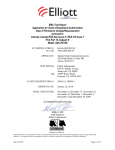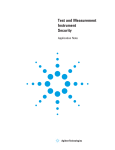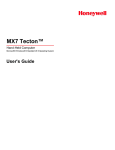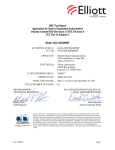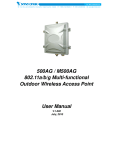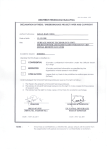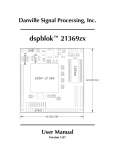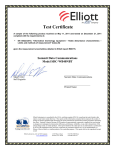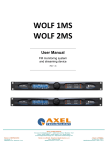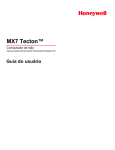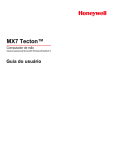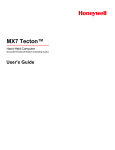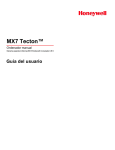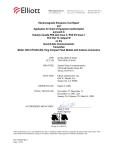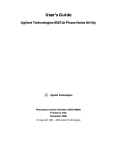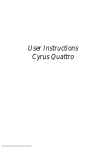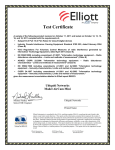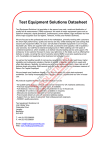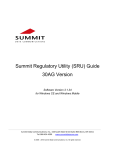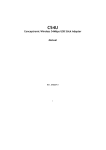Download Test Report - Summit Data Communications
Transcript
EMC Test Report Application for Grant of Equipment Authorization pursuant to Industry Canada RSS-Gen Issue 2 / RSS 210 Issue 7 FCC Part 15, Subpart E Model: SDC-MSD30AG IC CERTIFICATION #: FCC ID: APPLICANT: TEST SITE(S): IC SITE REGISTRATION #: REPORT DATE: FINAL TEST DATES: 6616A-SDCMSD30AG TWG-SDCMSD30AG Summit Data Communications Inc. 526 South Main St. Suite 805 Akron, OH 44311 Elliott Laboratories 41039 Boyce Road. Fremont, CA. 94538-2435 2845B-3; 2845B-5 April 12, 2010 January 11, 12, 13 and 14, 2010 AUTHORIZED SIGNATORY: ______________________________ Mark E. Hill Staff Engineer Elliott Laboratories Testing Cert #2016-01 Elliott Laboratories is accredited by the A2LA, certificate number 2016-01, to perform the test(s) listed in this report, except where noted otherwise. This report shall not be reproduced, except in its entirety, without the written approval of Elliott Laboratories File: R78443 Page 1 of 21 Elliott Laboratories -- EMC Department Test Report Report Date: April 12, 2010 REVISION HISTORY Rev# - File: R78443 Date April 12, 2010 Comments Modified By First release Page 2 of 21 Elliott Laboratories -- EMC Department Test Report Report Date: April 12, 2010 TABLE OF CONTENTS COVER PAGE.............................................................................................................................................................1 REVISION HISTORY................................................................................................................................................2 TABLE OF CONTENTS ............................................................................................................................................3 SCOPE..........................................................................................................................................................................4 OBJECTIVE ................................................................................................................................................................5 STATEMENT OF COMPLIANCE...........................................................................................................................5 DEVIATIONS FROM THE STANDARDS..............................................................................................................5 TEST RESULTS SUMMARY ...................................................................................................................................6 UNII / LELAN DEVICES ........................................................................................................................................6 GENERAL REQUIREMENTS APPLICABLE TO ALL BANDS..........................................................................8 MEASUREMENT UNCERTAINTIES....................................................................................................................8 EQUIPMENT UNDER TEST (EUT) DETAILS......................................................................................................9 GENERAL................................................................................................................................................................9 ANTENNA SYSTEM ..............................................................................................................................................9 ENCLOSURE...........................................................................................................................................................9 MODIFICATIONS...................................................................................................................................................9 SUPPORT EQUIPMENT.......................................................................................................................................10 EUT INTERFACE PORTS ....................................................................................................................................10 EUT OPERATION .................................................................................................................................................10 TEST SITE.................................................................................................................................................................11 GENERAL INFORMATION.................................................................................................................................11 CONDUCTED EMISSIONS CONSIDERATIONS ..............................................................................................11 RADIATED EMISSIONS CONSIDERATIONS ..................................................................................................11 MEASUREMENT INSTRUMENTATION ............................................................................................................12 RECEIVER SYSTEM ............................................................................................................................................12 INSTRUMENT CONTROL COMPUTER ............................................................................................................12 LINE IMPEDANCE STABILIZATION NETWORK (LISN)...............................................................................12 FILTERS/ATTENUATORS ..................................................................................................................................12 ANTENNAS...........................................................................................................................................................13 ANTENNA MAST AND EQUIPMENT TURNTABLE .......................................................................................13 INSTRUMENT CALIBRATION...........................................................................................................................13 TEST PROCEDURES ..............................................................................................................................................14 EUT AND CABLE PLACEMENT ........................................................................................................................14 CONDUCTED EMISSIONS..................................................................................................................................14 RADIATED EMISSIONS......................................................................................................................................14 RADIATED EMISSIONS......................................................................................................................................15 CONDUCTED EMISSIONS FROM ANTENNA PORT ......................................................................................17 BANDWIDTH MEASUREMENTS ......................................................................................................................17 SPECIFICATION LIMITS AND SAMPLE CALCULATIONS ...........................................................................18 CONDUCTED EMISSIONS SPECIFICATION LIMITS: FCC 15.207; FCC 15.107(A), RSS GEN ..................18 GENERAL TRANSMITTER RADIATED EMISSIONS SPECIFICATION LIMITS .........................................18 FCC 15.407 (A) OUTPUT POWER LIMITS .........................................................................................................19 OUTPUT POWER LIMITS –LELAN DEVICES..................................................................................................19 OUTPUT POWER AND SPURIOUS LIMITS –UNII AND LELAN DEVICES ..................................................20 SAMPLE CALCULATIONS - CONDUCTED EMISSIONS ...............................................................................20 SAMPLE CALCULATIONS - RADIATED EMISSIONS....................................................................................20 SAMPLE CALCULATIONS - FIELD STRENGTH TO EIRP CONVERSION...................................................21 APPENDIX A TEST EQUIPMENT CALIBRATION DATA ................................................................................1 APPENDIX B TEST DATA .......................................................................................................................................2 File: R78443 Page 3 of 21 Elliott Laboratories -- EMC Department Test Report Report Date: April 12, 2010 SCOPE An electromagnetic emissions test has been performed on the Summit Data Communications Inc. model SDC-MSD30AG, pursuant to the following rules: Industry Canada RSS-Gen Issue 2 RSS 210 Issue 7 “Low-power Licence-exempt Radiocommunication Devices (All Frequency Bands): Category I Equipment” FCC Part 15, Subpart E requirements for UNII Devices (using FCC DA 02-2138, August 30, 2002) Conducted and radiated emissions data has been collected, reduced, and analyzed within this report in accordance with measurement guidelines set forth in the following reference standards and as outlined in Elliott Laboratories test procedures: ANSI C63.4:2003 FCC UNII test procedure 2002-08 DA-02-2138, August 2002 The intentional radiator above has been tested in a simulated typical installation to demonstrate compliance with the relevant Industry Canada performance and procedural standards. Final system data was gathered in a mode that tended to maximize emissions by varying orientation of EUT, orientation of power and I/O cabling, antenna search height, and antenna polarization. Every practical effort was made to perform an impartial test using appropriate test equipment of known calibration. All pertinent factors have been applied to reach the determination of compliance. File: R78443 Page 4 of 21 Elliott Laboratories -- EMC Department Test Report Report Date: April 12, 2010 OBJECTIVE The primary objective of the manufacturer is compliance with the regulations outlined in the previous section. Prior to marketing in the USA, all unlicensed transmitters and transceivers require certification. Receive-only devices operating between 30 MHz and 960 MHz are subject to either certification or a manufacturer’s declaration of conformity, with all other receive-only devices exempt from the technical requirements. Prior to marketing in Canada, Class I transmitters, receivers and transceivers require certification. Class II devices are required to meet the appropriate technical requirements but are exempt from certification requirements. Certification is a procedure where the manufacturer submits test data and technical information to a certification body and receives a certificate or grant of equipment authorization upon successful completion of the certification body’s review of the submitted documents. Once the equipment authorization has been obtained, the label indicating compliance must be attached to all identical units, which are subsequently manufactured. Maintenance of compliance is the responsibility of the manufacturer. Any modification of the product which may result in increased emissions should be checked to ensure compliance has been maintained (i.e., printed circuit board layout changes, different line filter, different power supply, harnessing or I/O cable changes, etc.). STATEMENT OF COMPLIANCE The tested sample of Summit Data Communications Inc. model SDC-MSD30AG complied with the requirements of the following regulations: RSS 210 Issue 7 “Low-power Licence-exempt Radiocommunication Devices (All Frequency Bands): Category I Equipment” FCC Part 15, Subpart E requirements for UNII Devices Maintenance of compliance is the responsibility of the manufacturer. Any modifications to the product should be assessed to determine their potential impact on the compliance status of the device with respect to the standards detailed in this test report. The test results recorded herein are based on a single type test of Summit Data Communications Inc. model SDC-MSD30AG and therefore apply only to the tested sample. The sample was selected and prepared by Jerry Pohmurski of Summit Data Communications Inc.. DEVIATIONS FROM THE STANDARDS No deviations were made from the published requirements listed in the scope of this report. File: R78443 Page 5 of 21 Elliott Laboratories -- EMC Department Test Report Report Date: April 12, 2010 TEST RESULTS SUMMARY UNII / LELAN DEVICES Operation in the 5.15 – 5.25 GHz Band FCC RSS Description Rule Part Rule Part 15.407(e) Indoor operation only 15.407(a) 26dB Bandwidth (1) 15.407 (a) A9.2(1) Output Power (1) 15.407 (a) Power Spectral (1) Density A9.5 (2) 15.407(b) Spurious Emissions A9.3 (5) / 15.209 below 1GHz Spurious Emissions 15.407(b) A9.3 above 1GHz (2) 15.407(a)(6) Peak Excursion Ratio Measured Value / Comments Refer to user’s manual Limit / Requirement Result N/A Limits output power if < 20MHz Complies 17dBm Complies 802.11a: -0.8 dBm/MHz 4 dBm/MHz Complies 5 dBm/MHz Complies No emissions found Refer to Standard Complies Refer to Standard Complies < 13dB Complies 26.0 MHz 802.11a: 10.8 dBm (0.012W) 51.1dBµV/m @ 5147.7MHz (-2.9dB) 12.8 dB N/A Operation in the 5.25 – 5.35 GHz Band Note: The device is restricted to indoor use only, therefore the spectral density of spurious emissions in the 5.15 – 5.25 GHz band were limited to the power spectral limits for intentional signals detailed in FCC 15.407(a)(1) and RSS 210 6.2.2 q1 (i) Result Measured Value / FCC RSS Limit / Requirement Description (margin) Comments Rule Part Rule Part 15.407(a) N/A – limits output 26dB Bandwidth 26.2 MHz N/A (2) power if < 20MHz 802.11a: 10.3 dBm 24dBm 15.407(a) Complies A9.2(2) Output Power (0.011 W) (250mW) (2) 802.11a: 3.4 15.407(a) 11 dBm/MHz Complies Power Spectral Density dBm/MHz (2)) Shall not exceed the A9.5 (2) Peak Spectral Density 3.4 dBm/MHz average value by Complies more than 3dB Spurious Emissions 15.407(b) No emissions found Refer to Standard Complies A9.3 below 1GHz (5) / 15.209 15.407(b) Spurious Emissions 50.6dBµV/m @ A9.3 Refer to Standard Complies (2) above 1GHz 5350.1MHz (-3.4dB) 15.407(a)(6) Peak Excursion Ratio 12.1 dB < 13dB Complies File: R78443 Page 6 of 21 Elliott Laboratories -- EMC Department Test Report Report Date: April 12, 2010 Operation in the 5.47 – 5.725 GHz Band Measured Value / FCC RSS Limit / Requirement Description Comments Rule Part Rule Part Limits output power 15.407(a) 26dB Bandwidth 26.3 MHz if < 20MHz (2) 15.407(a) 802.11a: 10.5 dBm 24 dBm / 250mW A9.2(2) Output Power (2) (0.011 W) (eirp < 30dBm) 15.407(a) Power Spectral Density 11 dBm/MHz (2)) 802.11a: 1.5 dBm/MHz A9.2(2) / Power Spectral Density 11 dBm / MHz A9.5 (2) Non-operation in Device cannot operate in the 5600 – 5650 N/A A9 5600 – 5650 MHz MHz band –refer to Operational Description sub band Spurious Emissions 15.407(b) No emissions found Refer to Standard A9.3 below 1GHz (5) / 15.209 15.407(b) Spurious Emissions 50.7dBµV/m @ A9.3 Refer to Standard (2) above 1GHz 5458.7MHz (-3.3dB) 15.407(a)(6) Peak Excursion Ratio 12.9 dB < 13dB Requirements for all U-NII/LELAN bands RSS Measured Value / FCC Description Limit / Requirement Rule Part Rule Part Comments Digital Modulation is Digital modulation 15.407 A9.5a Modulation used is required Spurious Emissions 15.407(b) No emissions found Refer to Standard A9.3 below 1GHz (5) / 15.209 Spurious Emissions 51.1dBµV/m @ 15.407(b) Refer to Standard A9.3 above 1GHz 5147.7MHz (-2.9dB) (2) 15.407(a)(6) Peak Excursion Ratio 12.9 dB < 13dB Spurious emissions A9.5 (3) tested at outermost Device was tested channels in each band on the top, bottom Channel Selection and center channels Measurements on 15 three channels in each in each band band Device shall automatically Operation is Operation in the discontinue discontinued in the absence of operation in the 15.407 (c) A9.5(4) absence of information to absence of information transmit information to transmit Frequency stability is 15.407 (g) A9.5 (5) Frequency Stability better than 10ppm The U-NII device shall have the TPC is not required capability to operate Transmit Power as the device operates 15.407 (h1) A9.4 with a mean EIRP Control at below 500mW eirp value lower than 24dBm (250mW) Channel move time Dynamic frequency Refer to separate test < 10s Selection (device report, reference Channel closing 15.407 (h2) A9.4 without radar R78278 transmission time < detection) 260ms File: R78443 Result (margin) N/A Complies Complies Complies Complies Complies Complies Complies Result Complies Complies Complies Complies N/A Complies Complies Complies Complies Complies Page 7 of 21 Elliott Laboratories -- EMC Department Test Report Report Date: April 12, 2010 GENERAL REQUIREMENTS APPLICABLE TO ALL BANDS FCC Rule Part RSS Rule part Description 15.203 - RF Connector RSS GEN 7.2.3 Table 1 RSS GEN Table 2 15.109 15.207 15.247 (b) (5) 15.407 (f) - AC Conducted Emissions RF Exposure Requirements RSS 102 RSP 100 RSS GEN 7.1.5 RSP 100 RSS GEN 7.1.5 RSP 100 RSS GEN 4.4.1 - Receiver spurious emissions Measured Value / Comments The EUT uses u.FL connectors 44.3dBµV/m (164.1µV/m) @ 3720.0MHz (-9.7dB) 45.1dBµV @ 0.176MHz (-19.6dB) Refer to MPE calculations in Exhibit 11, RSS 102 declaration and User Manual statements. Result (margin) Refer to standard Complies Refer to standard Complies Refer to standard Complies Refer to OET 65, FCC Part 1 and RSS 102 Complies Statement required regarding noninterference Statement for products with detachable antenna User Manual User Manual 99% Bandwidth Limit / Requirement 5.1GHz: 16.9 MHz 5.25GHz: 17.1 MHz 5.47GHz: 17.1 MHz Complies Complies Information only N/A MEASUREMENT UNCERTAINTIES ISO/IEC 17025 requires that an estimate of the measurement uncertainties associated with the emissions test results be included in the report. The measurement uncertainties given below are based on a 95% confidence level and were calculated in accordance with UKAS document LAB 34. Measurement Type Frequency Range Calculated Uncertainty (MHz) (dB) ______________________________________________________________ Conducted Emissions Radiated Emissions Radiated Emissions Radiated Emissions File: R78443 0.15 to 30 0.015 to 30 30 to 1000 1000 to 40000 ± 2.4 ± 3.0 ± 3.6 ± 6.0 Page 8 of 21 Elliott Laboratories -- EMC Department Test Report Report Date: April 12, 2010 EQUIPMENT UNDER TEST (EUT) DETAILS GENERAL The Summit Data Communications Inc. model SDC-MSD30AG is a 802.11ag compliant wireless LAN radio Module which is designed to provide wireless local area networking connectivity. Normally, the EUT would be embedded in various types of mobile and stationary computing devices such as handheld and vehicle mounted data terminals during operation. The EUT was, therefore, placed in this position during emissions testing to simulate the end user environment. The electrical rating of the EUT is 3.3 VDC =/-5%. It’s typical power consumption is 400mA (1320mW) while in transmit mode, 180mA (594mW) while in receive mode and 10mA (33mW) while in standby mode. The sample was received on November 8, 2009 and tested on January 11, 12, 13 and 14, 2010. The EUT consisted of the following component(s): Company Model Description Summit Data SDC-MSD30AG 802.11AG Mini Communications Compact Flash Inc. Module with antenna connectors Serial Number - FCC ID TWGSDCMSD30AG ANTENNA SYSTEM The SDC-MSD30AG will be marketed with the following antenna options: Monopole Antenna - 2.4 and 5GHz bands, Huber+Suhner, SOA 2459/360/5/0/V_C, 3dBi (2.4GHz), 6.5dBi (5GHz) Dipole Antenna #1 - 2.4 and 5GHz bands - Larsen, R380.500.314, 1.6dBi (2.4GHz), 5dBi (5GHz) Dipole Antenna #2 - 2.4 GHz only - Cisco Air-Ant 4941 2dBi(2.4GHz) Dipole Antenna #3 - 5GHz only - Cisco Air-Ant 5135 3.5dBi(5GHz) Dipole Antenna #4 - 2.4GHz only - Summit SDC-CF22G - 0dBi ENCLOSURE The EUT does not have an enclosure as it is designed to be installed within the enclosure of a host computer or system. MODIFICATIONS No modifications were made to the EUT during the time the product was at Elliott. File: R78443 Page 9 of 21 Elliott Laboratories -- EMC Department Test Report Report Date: April 12, 2010 SUPPORT EQUIPMENT The following equipment was used as support equipment for testing: Company Hewlett Packard Model iPAQ Description Handheld Computer Serial Number - FCC ID - No remote support equipment was used during testing. EUT INTERFACE PORTS The I/O cabling configuration during testing was as follows: Port Connected To iPAQ Power AC Mains Flash Module iPAQ Module Port Description 2wire - Cable(s) Shielded or Unshielded Unshielded - Length(m) 1.5 - EUT OPERATION During emissions testing the EUT was configured to transmit at the Low, Middle, and High Channel. Testing performed at 6Mbs for 802.11a mode. File: R78443 Page 10 of 21 Elliott Laboratories -- EMC Department Test Report Report Date: April 12, 2010 TEST SITE GENERAL INFORMATION Final test measurements were taken on January 11, 12, 13 and 14, 2010 at the test sites listed below. Pursuant to section 2.948 of the FCC’s Rules and section 3.3 of RSP-100, construction, calibration, and equipment data has been filed with the Commission and with industry Canada. Site Chamber 3 Chamber 5 Registration Numbers FCC Canada 769238 2845B-3 211948 2845B-5 Location 41039 Boyce Road Fremont, CA 94538-2435 ANSI C63.4:2003 recommends that ambient noise at the test site be at least 6 dB below the allowable limits. Ambient levels are below this requirement. The test site(s) contain separate areas for radiated and conducted emissions testing. Considerable engineering effort has been expended to ensure that the facilities conform to all pertinent requirements of ANSI C63.4:2003. CONDUCTED EMISSIONS CONSIDERATIONS Conducted emissions testing is performed in conformance with ANSI C63.4:2003. Measurements are made with the EUT connected to the public power network through a nominal, standardized RF impedance, which is provided by a line impedance stabilization network, known as a LISN. A LISN is inserted in series with each currentcarrying conductor in the EUT power cord. RADIATED EMISSIONS CONSIDERATIONS The FCC has determined that radiation measurements made in a shielded enclosure are not suitable for determining levels of radiated emissions. Radiated measurements are performed in an open field environment or in a semi-anechoic chamber. The test sites are maintained free of conductive objects within the CISPR defined elliptical area incorporated in ANSI C63.4:2003 guidelines and meet the Normalized Site Attenuation (NSA) requirements of ANSI C63.4:2003. File: R78443 Page 11 of 21 Elliott Laboratories -- EMC Department Test Report Report Date: April 12, 2010 MEASUREMENT INSTRUMENTATION RECEIVER SYSTEM An EMI receiver as specified in CISPR 16-1-1 is used for emissions measurements. The receivers used can measure over the frequency range of 9 kHz up to 2000 MHz. These receivers allow both ease of measurement and high accuracy to be achieved. The receivers have Peak, Average, and CISPR (Quasi-peak) detectors built into their design so no external adapters are necessary. The receiver automatically sets the required bandwidth for the CISPR detector used during measurements. If the repetition frequency of the signal being measured is below 20Hz, peak measurements are made in lieu of Quasi-Peak measurements. For measurements above the frequency range of the receivers, a spectrum analyzer is utilized because it provides visibility of the entire spectrum along with the precision and versatility required to support engineering analysis. Average measurements above 1000MHz are performed on the spectrum analyzer using the linear-average method with a resolution bandwidth of 1 MHz and a video bandwidth of 10 Hz, unless the signal is pulsed in which case the average (or video) bandwidth of the measuring instrument is reduced to onset of pulse desensitization and then increased. INSTRUMENT CONTROL COMPUTER The receivers utilize either a Rohde & Schwarz EZM Spectrum Monitor/Controller or contain an internal Spectrum Monitor/Controller to view and convert the receiver measurements to the field strength at an antenna or voltage developed at the LISN measurement port, which is then compared directly with the appropriate specification limit. This provides faster, more accurate readings by performing the conversions described under Sample Calculations within the Test Procedures section of this report. Results are printed in a graphic and/or tabular format, as appropriate. A personal computer is used to record all measurements made with the receivers. The Spectrum Monitor provides a visual display of the signal being measured. In addition, the controller or a personal computer run automated data collection programs which control the receivers. This provides added accuracy since all site correction factors, such as cable loss and antenna factors are added automatically. LINE IMPEDANCE STABILIZATION NETWORK (LISN) Line conducted measurements utilize a fifty microhenry Line Impedance Stabilization Network as the monitoring point. The LISN used also contains a 250 uH CISPR adapter. This network provides for calibrated radio frequency noise measurements by the design of the internal low pass and high pass filters on the EUT and measurement ports, respectively. FILTERS/ATTENUATORS External filters and precision attenuators are often connected between the receiving antenna or LISN and the receiver. This eliminates saturation effects and non-linear operation due to high amplitude transient events. File: R78443 Page 12 of 21 Elliott Laboratories -- EMC Department Test Report Report Date: April 12, 2010 ANTENNAS A loop antenna is used below 30 MHz. For the measurement range 30 MHz to 1000 MHz either a combination of a biconical antenna and a log periodic or a bi-log antenna is used. Above 1000 MHz, horn antennas are used. The antenna calibration factors to convert the received voltage to an electric field strength are included with appropriate cable loss and amplifier gain factors to determine an overall site factor, which is then programmed into the test receivers or incorporated into the test software. ANTENNA MAST AND EQUIPMENT TURNTABLE The antennas used to measure the radiated electric field strength are mounted on a nonconductive antenna mast equipped with a motor-drive to vary the antenna height. Measurements below 30 MHz are made with the loop antenna at a fixed height of 1m above the ground plane. ANSI C63.4:2003 specifies that the test height above ground for table mounted devices shall be 80 centimeters. Floor mounted equipment shall be placed on the ground plane if the device is normally used on a conductive floor or separated from the ground plane by insulating material from 3 to 12 mm if the device is normally used on a non-conductive floor. During radiated measurements, the EUT is positioned on a motorized turntable in conformance with this requirement. INSTRUMENT CALIBRATION All test equipment is regularly checked to ensure that performance is maintained in accordance with the manufacturer's specifications. All antennas are calibrated at regular intervals with respect to tuned half-wave dipoles. An exhibit of this report contains the list of test equipment used and calibration information. File: R78443 Page 13 of 21 Elliott Laboratories -- EMC Department Test Report Report Date: April 12, 2010 TEST PROCEDURES EUT AND CABLE PLACEMENT The regulations require that interconnecting cables be connected to the available ports of the unit and that the placement of the unit and the attached cables simulate the worst case orientation that can be expected from a typical installation, so far as practicable. To this end, the position of the unit and associated cabling is varied within the guidelines of ANSI C63.4:2003, and the worst-case orientation is used for final measurements. CONDUCTED EMISSIONS Conducted emissions are measured at the plug end of the power cord supplied with the EUT. Excess power cord length is wrapped in a bundle between 30 and 40 centimeters in length near the center of the cord. Preliminary measurements are made to determine the highest amplitude emission relative to the specification limit for all the modes of operation. Placement of system components and varying of cable positions are performed in each mode. A final peak mode scan is then performed in the position and mode for which the highest emission was noted on all current carrying conductors of the power cord. LISN EUT LISN AE 0.4m 0.8m File: R78443 Page 14 of 21 Elliott Laboratories -- EMC Department Test Report Report Date: April 12, 2010 RADIATED EMISSIONS A preliminary scan of the radiated emissions is performed in which all significant EUT frequencies are identified with the system in a nominal configuration. At least two scans are performed, one scan for each antenna polarization (horizontal and vertical; loop parallel and perpendicular to the EUT). During the preliminary scans, the EUT is rotated through 360˚, the antenna height is varied (for measurements above 30 MHz) and cable positions are varied to determine the highest emission relative to the limit. Preliminary scans may be performed in a fully anechoic chamber for the purposes of identifying the frequencies of the highest emissions from the EUT. A speaker is provided in the receiver to aid in discriminating between EUT and ambient emissions. Other methods used during the preliminary scan for EUT emissions involve scanning with near field magnetic loops, monitoring I/O cables with RF current clamps, and cycling power to the EUT. Final maximization is a phase in which the highest amplitude emissions identified in the spectral search are viewed while the EUT azimuth angle is varied from 0 to 360 degrees relative to the receiving antenna. The azimuth, which results in the highest emission is then maintained while varying the antenna height from one to four meters (for measurements above 30 MHz, measurements below 30 MHz are made with the loop antenna at a fixed height of 1m). The result is the identification of the highest amplitude for each of the highest peaks. Each recorded level is corrected in the receiver using appropriate factors for cables, connectors, antennas, and preamplifier gain. When testing above 18 GHz, the receive antenna is located at 1meter from the EUT and the antenna height is restricted to a maximum of 2.5 meters. REAR VIEW 0.4m AC Outlets (flush-mounted) 0.8m SIDE VIEW Typical Test Configuration for Radiated Field Strength Measurements File: R78443 Page 15 of 21 Elliott Laboratories -- EMC Department Test Report Report Date: April 12, 2010 EUT d Antenna The anechoic materials on the walls and ceiling ensure compliance with the normalized site attenuation requirements of CISPR 16 / CISPR 22 / ANSI C63.4 for an alternate test site at the measurement distances used. Floor-standing equipment is placed on the floor with insulating supports between the unit and the ground plane. EUT d Antenna height range 1 to 4 m 0.8m Test Configuration for Radiated Field Strength Measurements Semi-Anechoic Chamber, Plan and Side Views File: R78443 Page 16 of 21 Elliott Laboratories -- EMC Department Test Report Report Date: April 12, 2010 CONDUCTED EMISSIONS FROM ANTENNA PORT Direct measurements of power, bandwidth and power spectral density are performed, where possible, with the antenna port of the EUT connected to either the power meter or spectrum analyzer via a suitable attenuator and/or filter. These are used to ensure that the front end of the measurement instrument is not overloaded by the fundamental transmission. EUT Attenuator (optional) Spectrum Analyzer (or Power Meter) Test Configuration for Antenna Port Measurements Measurement bandwidths (video and resolution) are set in accordance with the relevant standards and Elliott’s test procedures for the type of radio being tested. When power measurements are made using a resolution bandwidth less than the signal bandwidth the power is calculated by summing the power across the signal bandwidth using either the analyzer channel power function or by capturing the trace data and calculating the power using software. In both cases the summed power is corrected to account for the equivalent noise bandwidth (ENBW) of the resolution bandwidth used. If power averaging is used (typically for certain digital modulation techniques), the EUT is configured to transmit continuously. Power averaging is performed using either the built-in function of the analyzer or, if the analyzer does not feature power averaging, using external software. In both cases the average power is calculated over a number of sweeps (typically 100). When the EUT cannot be configured to continuously transmit then either the analyzer is configured to perform a gated sweep to ensure that the power is averaged over periods that the device is transmitting or power averaging is disabled and a max-hold feature is used. If a power meter is used to make output power measurements the sensor head type (peak or average) is stated in the test data table. BANDWIDTH MEASUREMENTS The 6dB, 20dB and/or 26dB signal bandwidth is measured in using the bandwidths recommended by ANSI C63.4. When required, the 99% bandwidth is measured using the methods detailed in RSS GEN. File: R78443 Page 17 of 21 Elliott Laboratories -- EMC Department Test Report Report Date: April 12, 2010 SPECIFICATION LIMITS AND SAMPLE CALCULATIONS The limits for conducted emissions are given in units of microvolts, and the limits for radiated emissions are given in units of microvolts per meter at a specified test distance. Data is measured in the logarithmic form of decibels relative to one microvolt, or dB microvolts (dBuV). For radiated emissions, the measured data is converted to the field strength at the antenna in dB microvolts per meter (dBuV/m). The results are then converted to the linear forms of uV and uV/m for comparison to published specifications. For reference, converting the specification limits from linear to decibel form is accomplished by taking the base ten logarithm, then multiplying by 20. These limits in both linear and logarithmic form are as follows: CONDUCTED EMISSIONS SPECIFICATION LIMITS: FCC 15.207; FCC 15.107(a), RSS GEN The table below shows the limits for the emissions on the AC power line from an intentional radiator and a receiver. Frequency (MHz) 0.150 to 0.500 0.500 to 5.000 5.000 to 30.000 Average Limit (dBuV) Linear decrease on logarithmic frequency axis between 56.0 and 46.0 46.0 50.0 Quasi Peak Limit (dBuV) Linear decrease on logarithmic frequency axis between 66.0 and 56.0 56.0 60.0 GENERAL TRANSMITTER RADIATED EMISSIONS SPECIFICATION LIMITS The table below shows the limits for the spurious emissions from transmitters that fall in restricted bands1 (with the exception of transmitters operating under FCC Part 15 Subpart D and RSS 210 Annex 9), the limits for all emissions from a low power device operating under the general rules of RSS 310 (tables 3 and 4), RSS 210 (table 2) and FCC Part 15 Subpart C section 15.209. 1 Frequency Limit (uV/m) Range (MHz) 0.009-0.490 2400/FKHz @ 300m 67.6-20*log10(FKHz) @ 300m 0.490-1.705 24000/FKHz @ 30m 87.6-20*log10(FKHz) @ 30m 1.705 to 30 30 @ 30m 29.5 @ 30m 30 to 88 100 @ 3m 40 @ 3m 88 to 216 150 @ 3m 43.5 @ 3m 216 to 960 200 @ 3m 46.0 @ 3m Above 960 500 @ 3m 54.0 @ 3m Limit (dBuV/m @ 3m) The restricted bands are detailed in FCC 15.203, RSS 210 Table 1 and RSS 310 Table 2 File: R78443 Page 18 of 21 Elliott Laboratories -- EMC Department Test Report Report Date: April 12, 2010 FCC 15.407 (a) OUTPUT POWER LIMITS The table below shows the limits for output power and output power density. Where the signal bandwidth is less than 20 MHz the maximum output power is reduced to the power spectral density limit plus 10 times the log of the bandwidth (in MHz). Operating Frequency (MHz) 5150 - 5250 5250 - 5350 5725 – 5825 Output Power 50mW (17 dBm) 250 mW (24 dBm) 1 Watts (30 dBm) Power Spectral Density 4 dBm/MHz 11 dBm/MHz 17 dBm/MHz For system using antennas with gains exceeding 6dBi, the output power and power spectral density limits are reduced by 1dB for every dB the antenna gain exceeds 6dBi. Fixed point-to-point applications using the 5725 – 5825 MHz band may use antennas with gains of up to 23dBi without this limitation. If the gain exceeds 23dBi then the output power limit of 1 Watt is reduced by 1dB for every dB the gain exceeds 23dBi. The peak excursion envelope is limited to 13dB. OUTPUT POWER LIMITS –LELAN DEVICES The table below shows the limits for output power and output power density defined by RSS 210. Where the signal bandwidth is less than 20 MHz the maximum output power is reduced to the power spectral density limit plus 10 times the log of the bandwidth (in MHz). Operating Frequency (MHz) 5150 - 5250 5250 - 5350 5470 - 5725 5725 – 5825 Output Power 200mW (23 dBm) eirp 250 mW (24 dBm)2 1W (30dBm) eirp 250 mW (24 dBm)3 1W (30dBm) eirp 1 Watts (30 dBm) 4W eirp Power Spectral Density 10 dBm/MHz eirp 11 dBm/MHz 11 dBm/MHz 17 dBm/MHz In addition, the power spectral density limit shall be reduced by 1dB for every dB the highest power spectral density exceeds the “average” power spectral density ) by more than 3dB. The “average” power spectral density is determined by dividing the output power by 10log(EBW) where EBW is the 99% power bandwidth. Fixed point-to-point applications using the 5725 – 5825 MHz band may use antennas with gains of up to 23dBi without this limitation. If the gain exceeds 23dBi then the output power limit of 1 Watt is reduced by 1dB for every dB the gain exceeds 23dBi. 2 3 If EIRP exceeds 500mW the device must employ TPC If EIRP exceeds 500mW the device must employ TPC File: R78443 Page 19 of 21 Elliott Laboratories -- EMC Department Test Report Report Date: April 12, 2010 OUTPUT POWER AND SPURIOUS LIMITS –UNII and LELAN DEVICES The spurious emissions limits for signals below 1GHz are the FCC/RSS-GEN general limits. For emissions above 1GHz, signals in restricted bands are subject to the FCC/RSS GEN general limits. All other signals have a limit of –27dBm/MHz, which is a field strength of 68.3dBuV/m/MHz at a distance of 3m. This is an average limit so the peak value of the emission may not exceed –7dBm/MHz (68.3dBuV/m/MHz at a distance of 3m). For devices operating in the 5725-5850Mhz bands under the LELAN/UNII rules, the limit within 10Mhz of the allocated band is increased to – 17dBm/MHz. SAMPLE CALCULATIONS - CONDUCTED EMISSIONS Receiver readings are compared directly to the conducted emissions specification limit (decibel form) as follows: Rr - S = M where: Rr = Receiver Reading in dBuV S = Specification Limit in dBuV M = Margin to Specification in +/- dB SAMPLE CALCULATIONS - RADIATED EMISSIONS Receiver readings are compared directly to the specification limit (decibel form). The receiver internally corrects for cable loss, preamplifier gain, and antenna factor. The calculations are in the reverse direction of the actual signal flow, thus cable loss is added and the amplifier gain is subtracted. The Antenna Factor converts the voltage at the antenna coaxial connector to the field strength at the antenna elements. A distance factor, when used for electric field measurements above 30MHz, is calculated by using the following formula: Fd = 20*LOG10 (Dm/Ds) where: Fd = Distance Factor in dB Dm = Measurement Distance in meters Ds = Specification Distance in meters For electric field measurements below 30MHz the extrapolation factor is either determined by making measurements at multiple distances or a theoretical value is calculated using the formula: Fd = 40*LOG10 (Dm/Ds) Measurement Distance is the distance at which the measurements were taken and Specification Distance is the distance at which the specification limits are based. The antenna factor converts the voltage at the antenna coaxial connector to the field strength at the antenna elements. File: R78443 Page 20 of 21 Elliott Laboratories -- EMC Department Test Report Report Date: April 12, 2010 The margin of a given emission peak relative to the limit is calculated as follows: Rc = Rr + Fd and M = Rc - Ls where: Rr = Receiver Reading in dBuV/m Fd = Distance Factor in dB Rc = Corrected Reading in dBuV/m Ls = Specification Limit in dBuV/m M = Margin in dB Relative to Spec SAMPLE CALCULATIONS - FIELD STRENGTH TO EIRP CONVERSION Where the radiated electric field strength is expressed in terms of the equivalent isotropic radiated power (eirp), or where a field strength measurement of output power is made in lieu of a direct measurement, the following formula is used to convert between eirp and field strength at a distance of 3m from the equipment under test: E = 1000000 √ 30 P microvolts per meter 3 where P is the eirp (Watts) File: R78443 Page 21 of 21 Elliott Laboratories -- EMC Department Test Report Report Date: April 12, 2010 Appendix A Test Equipment Calibration Data Radiated Emissions, 30 - 6,500 MHz, 11-Nov-09 Manufacturer Description EMCO Antenna, Horn, 1-18 GHz Hewlett Packard SpecAn 9 kHz - 40 GHz, FT (SA40) Blue Model 3115 8564E (84125C) Asset # 786 1393 Cal Due 12/6/2009 4/10/2010 Radiated Emissions, 1000 - 40,000 MHz, 11-Dec-09 Description Manufacturer EMCO Antenna, Horn, 1-18GHz Hewlett Packard SpecAn 9 kHz - 40 GHz, FT (SA40) Blue Micro-Tronics Band Reject Filter, 5150-5350 MHz Hewlett Packard Microwave Preamplifier, 1-26.5GHz Model 3115 8564E (84125C) BRC50703-02 8449B Asset # 868 1393 1729 1780 Cal Due 6/10/2010 4/10/2010 9/25/2010 9/17/2010 Radiated Emissions, 30 - 40,000 MHz, 12-Jan-10 Description Manufacturer Hewlett Packard Microwave Preamplifier, 1-26.5GHz EMCO Antenna, Horn, 1-18 GHz Micro-Tronics Band Reject Filter, 5150-5350 MHz Micro-Tronics Band Reject Filter, 5470-5725 MHz Hewlett Packard SpecAn 9 kHz - 40 GHz, (SA40) Purple Model 8449B 3115 BRC50703-02 BRC50704-02 8564E (84125C) Asset # 785 1561 1729 1730 1771 Cal Due 6/3/2010 6/10/2010 9/25/2010 9/25/2010 9/30/2010 , 10-Mar-09 Manufacturer Hewlett Packard Description Test Sys (SA40, 30Hz - 40GHz), Model 85620A Asset # Rental Cal Due 4/20/2009 , 12-Mar-09 Manufacturer Hewlett Packard Description Test Sys (SA40, 30Hz - 40GHz), Model # 85620A Asset # Rental Cal Due 4/20/2009 Asset # 1393 Cal Due 4/10/2010 Radio Antenna Port (Power and Spurious Emissions), 14-Jan-10 Description Model Manufacturer Hewlett Packard SpecAn 9 kHz - 40 GHz, FT (SA40) Blue 8564E (84125C) File: R78443 Appendix Page 1 of 2 Elliott Laboratories -- EMC Department Test Report Report Date: April 12, 2010 Appendix B Test Data T77318 34 Pages T77319 12 Pages File: R78443 Appendix Page 2 of 2 EMC Test Data Client: Summit Data Communications Model: SDC-MSD30AG Job Number: J77268 T-Log Number: T77318 Account Manager: Christine Krebill Contact: Jerry Pohmurski Emissions Standard(s): FCC 15.E/RSS 210 Immunity Standard(s): - Class: Environment: - EMC Test Data For The Summit Data Communications Model SDC-MSD30AG Date of Last Test: 1/14/2010 T77318_NII_Radiated_Final Cover Page 1 of 34 EMC Test Data Client: Summit Data Communications Job Number: J77268 T-Log Number: T77318 Account Manager: Christine Krebill Model: SDC-MSD30AG Contact: Jerry Pohmurski Standard: FCC 15.E/RSS 210 Class: N/A RSS 210 and FCC 15.407 (UNII) Radiated Spurious Emissions (H&S Antenna) Test Specific Details Objective: The objective of this test session is to perform final qualification testing of the EUT with respect to the specification listed above. General Test Configuration The EUT and all local support equipment were located on the turntable for radiated spurious emissions testing. For radiated emissions testing the measurement antenna was located 3 meters from the EUT. Ambient Conditions: Temperature: Rel. Humidity: Date of Test: Refer to each run Test Engineer: Refer to each run Test Location: Refer to each run 10-15 °C 30-50 % Config. Used: 1 Config Change: None Host Unit Voltage 120V/ 60Hz Modifications Made During Testing No modifications were made to the EUT during testing Deviations From The Standard No deviations were made from the requirements of the standard. T77318_NII_Radiated_Final UNII RE H&S-2A Module Page 2 of 34 EMC Test Data Client: Summit Data Communications Job Number: J77268 T-Log Number: T77318 Account Manager: Christine Krebill Model: SDC-MSD30AG Contact: Jerry Pohmurski Standard: FCC 15.E/RSS 210 Class: N/A Summary of Results NOTE: A preliminary check of output power was performed. The port with the highest power was used for the final testing. Preliminary tests showed no radio related emissions below 1 GHz. Run # 1 2 3 Mode Channel 802.11a Chain A 802.11a Chain A 802.11a Chain A 802.11a Chain A 802.11a Chain A 802.11a Chain A 802.11a Chain A 802.11a Chain A 802.11a Chain A 802.11a Chain A 802.11a Chain A 802.11a Chain A 802.11a Chain A 5150-5250 Low 5150-5250 Low 5150-5250 Center 5150-5250 High 5250-5350 Low 5250-5350 Center 5250-5350 High 5250-5350 High 5470-5725 Low 5470-5725 Low 5470-5725 Low 5470-5725 Center 5470-5725 High Power Setting Port 18 Main 18 Main 18 Main 18 Main 18 Main 18 Main 18 Main 18 Main 18 Main 18 Main 18 Main 18 Main 18 Main Antenna: H&S 6.5 dBi dipole antenna (Elliott 2009-1388) Module: 00000002A DRIVER: V3.00.50 Note: Test Performed Restricted Band Edge at 5150 MHz Radiated Emissions, 1 - 40 GHz Radiated Emissions, 1 - 40 GHz Radiated Emissions, 1 - 40 GHz Radiated Emissions, 1 - 40 GHz Radiated Emissions, 1 - 40 GHz Radiated Emissions, 1 - 40 GHz Restricted Band Edge at 5350 MHz Restricted Band Edge at 5460 MHz Restricted Band Edge at 5470 MHz Radiated Emissions, 1 - 40 GHz Radiated Emissions, 1 - 40 GHz Radiated Emissions, 1 - 40 GHz Limit 15.209 FCC 15.209 / 15 E FCC 15.209 / 15 E FCC 15.209 / 15 E FCC 15.209 / 15 E FCC 15.209 / 15 E FCC 15.209 / 15 E 15.209 15.209 15.209 FCC 15.209 / 15 E FCC 15.209 / 15 E FCC 15.209 / 15 E Result / Margin 49.6dBµV/m @ 5135.3MHz (-4.4dB) 40.3dBµV/m @ 5433.4MHz (-13.7dB) 39.7dBµV/m @ 5428.1MHz (-14.3dB) 39.9dBµV/m @ 5438.9MHz (-14.1dB) 41.0dBµV/m @ 15835.7MHz (-13.0dB) 41.7dBµV/m @ 15902.8MHz (-12.3dB) 43.5dBµV/m @ 1345.4MHz (-10.5dB) 49.2dBµV/m @ 5350.2MHz (-4.8dB) 43.4dBµV/m @ 5350.4MHz (-10.6dB) 44.5dBµV/m @ 5469.8MHz (-23.8dB) 46.9dBµV/m @ 10986.7MHz (-7.1dB) 46.9dBµV/m @ 3713.3MHz (-7.1dB) 47.1dBµV/m @ 3795.8MHz (-6.9dB) SCU: V2.03.18 For emission from 18-40GHz, the EUT was scanned manually. All signals were more than 20dB below the limit. T77318_NII_Radiated_Final UNII RE H&S-2A Module Page 3 of 34 EMC Test Data Client: Summit Data Communications Job Number: J77268 T-Log Number: T77318 Account Manager: Christine Krebill Model: SDC-MSD30AG Contact: Jerry Pohmurski Standard: FCC 15.E/RSS 210 Class: N/A Run #1, Radiated Spurious Emissions, 30 - 40,000 MH. Operation in the 5150-5250 MHz Band Date: 1/11/2010 Run #1a: Low Channel @ 5180 MHz Fundamental Signal Field Strength Frequency Level Pol MHz V/H dBμV/m 5179.800 96.0 V 5179.600 105.7 V 5179.930 92.3 H 5180.130 103.2 H Engineer: Suhaila Khushzad Location: FT Chamber #3 15.209 / 15.E Limit Margin - Detector Pk/QP/Avg AVG PK AVG PK Azimuth degrees 62 62 134 134 Height meters 1.4 1.4 1.4 1.4 Comments 5150 MHz Band Edge Signal Radiated Field Strength FCC 15.209 Frequency Level Pol MHz V/H Limit Margin dBμV/m 5135.270 49.6 V 54.0 -4.4 5142.000 49.4 H 54.0 -4.6 5141.000 61.2 V 74.0 -12.8 5144.870 61.4 H 74.0 -12.6 Detector Pk/QP/Avg AVG AVG PK PK Azimuth degrees 62 134 62 134 Height meters 1.4 1.4 1.4 1.4 Comments Spurious Radiated Emissions: Frequency Level Pol MHz V/H dBμV/m 5433.400 40.3 V 6906.740 47.4 V 10360.270 45.3 V 3453.360 46.3 V 5429.870 54.1 V 6906.800 53.0 V 10361.600 58.7 V Detector Pk/QP/Avg AVG AVG AVG PK PK PK PK Azimuth degrees 310 274 1 19 310 274 1 Height meters 2.2 1.0 1.0 1.0 2.2 1.0 1.0 Comments Note 1: Note 2: 15.209 / 15E Limit Margin 54.0 -13.7 68.3 -20.9 68.3 -23.0 68.3 -22.0 74.0 -19.9 88.3 -35.3 88.3 -29.6 Peak vs Avg limit For emissions in restricted bands, the limit of 15.209 was used. For all other emissions, the average limit was set to -27dBm/MHz (~68dBuV/m). No spurious emissions were found above 18GHz T77318_NII_Radiated_Final UNII RE H&S-2A Module Page 4 of 34 EMC Test Data Client: Summit Data Communications Job Number: J77268 T-Log Number: T77318 Account Manager: Christine Krebill Model: SDC-MSD30AG Contact: Jerry Pohmurski Standard: FCC 15.E/RSS 210 T77318_NII_Radiated_Final Class: N/A UNII RE H&S-2A Module Page 5 of 34 EMC Test Data Client: Summit Data Communications Job Number: J77268 T-Log Number: T77318 Account Manager: Christine Krebill Model: SDC-MSD30AG Contact: Jerry Pohmurski Standard: FCC 15.E/RSS 210 Class: N/A Run #1b: Center Channel @ 5200 MHz Spurious Radiated Emissions: 15.209 / 15E Frequency Level Pol MHz V/H Limit Margin dBμV/m 5428.090 39.7 V 54.0 -14.3 10400.200 44.8 V 68.3 -23.5 3466.750 46.4 V 68.3 -21.9 6933.340 50.7 V 68.3 -17.6 5429.160 52.2 V 74.0 -21.8 10400.530 59.1 V 88.3 -29.2 Note 1: Note 2: Detector Pk/QP/Avg AVG AVG Peak Peak PK PK Azimuth degrees 65 360 19 274 65 360 Height meters 2.2 1.0 1.0 1.3 2.2 1.0 Comments Peak vs Avg limit Peak vs Avg limit For emissions in restricted bands, the limit of 15.209 was used. For all other emissions, the average limit was set to -27dBm/MHz (~68dBuV/m). No spurious emissions were found above 18GHz T77318_NII_Radiated_Final UNII RE H&S-2A Module Page 6 of 34 EMC Test Data Client: Summit Data Communications Job Number: J77268 T-Log Number: T77318 Account Manager: Christine Krebill Model: SDC-MSD30AG Contact: Jerry Pohmurski Standard: FCC 15.E/RSS 210 Run #1c: High Channel @ 5240 MHz Spurious Radiated Emissions: Frequency Level Pol MHz V/H dBμV/m 3493.350 44.3 V 5438.860 39.9 V 6986.750 46.6 V 10480.050 42.5 V 3493.230 48.4 V 5436.330 52.4 V 6986.810 52.5 V 10482.320 56.1 V Note 1: Note 2: Class: N/A 15.209 / 15E Limit Margin 68.3 -24.0 54.0 -14.1 68.3 -21.7 68.3 -25.8 88.3 -39.9 74.0 -21.6 88.3 -35.8 88.3 -32.2 Detector Pk/QP/Avg AVG AVG AVG AVG PK PK PK PK Azimuth degrees 19 275 77 360 19 275 77 360 Height meters 1.0 1.5 1.1 1.0 1.0 1.5 1.1 1.0 Comments For emissions in restricted bands, the limit of 15.209 was used. For all other emissions, the average limit was set to -27dBm/MHz (~68dBuV/m). No spurious emissions were found above 18GHz T77318_NII_Radiated_Final UNII RE H&S-2A Module Page 7 of 34 EMC Test Data Client: Summit Data Communications Job Number: J77268 T-Log Number: T77318 Account Manager: Christine Krebill Model: SDC-MSD30AG Contact: Jerry Pohmurski Standard: FCC 15.E/RSS 210 Class: N/A Run #2, Radiated Spurious Emissions, 30 - 40,000 MH. Operation in the 5250-5350 MHz Band Date: 1/11/2010 Engineer: Suhaila Khushzad Location: FT Chamber #3 Run #2a: Low Channel @ 5280 MHz Spurious Radiated Emissions: Note: If device is not for indoor use only then measure 5250 MHz band edge to comply with -68.3dBuV/m limit 15.209 / 15E Azimuth Height Comments Frequency Level Pol Detector MHz V/H Limit Margin Pk/QP/Avg degrees meters dBμV/m AVG 274 2.1 5431.330 39.2 V 54.0 -14.8 3520.050 45.0 V 68.3 -23.3 Peak 20 1.0 Peak vs Avg limit 7040.020 50.2 V 68.3 -18.1 Peak 272 1.3 Peak vs Avg limit 10561.710 46.6 V 68.3 -21.7 Peak 5 1.3 Peak vs Avg limit 15835.690 41.0 V 54.0 -13.0 Peak 42 1.0 Peak vs Avg limit 274 2.1 5426.600 52.0 V 74.0 -22.0 PK Note 1: Note 2: For emissions in restricted bands, the limit of 15.209 was used. For all other emissions, the average limit was set to -27dBm/MHz (~68dBuV/m). No spurious emissions were found above 18GHz T77318_NII_Radiated_Final UNII RE H&S-2A Module Page 8 of 34 EMC Test Data Client: Summit Data Communications Job Number: J77268 T-Log Number: T77318 Account Manager: Christine Krebill Model: SDC-MSD30AG Contact: Jerry Pohmurski Standard: FCC 15.E/RSS 210 Class: N/A Run #2b: Center Channel @ 5300 MHz Spurious Radiated Emissions: 15.209 / 15E Frequency Level Pol MHz V/H Limit Margin dBμV/m 5435.930 39.8 V 54.0 -14.2 3533.390 45.3 V 68.3 -23.0 7066.730 50.9 V 68.3 -17.4 10600.000 45.9 V 68.3 -22.4 15902.810 41.7 H 54.0 -12.3 5427.930 52.6 V 74.0 -21.4 Note 1: Note 2: Detector Pk/QP/Avg AVG Peak Peak Peak Peak PK Azimuth degrees 270 32 101 341 61 270 Height meters 2.1 1.3 1.0 1.0 1.0 2.1 Comments Peak vs Avg limit Peak vs Avg limit For emissions in restricted bands, the limit of 15.209 was used. For all other emissions, the average limit was set to -27dBm/MHz (~68dBuV/m). No spurious emissions were found above 18GHz T77318_NII_Radiated_Final UNII RE H&S-2A Module Page 9 of 34 EMC Test Data Client: Summit Data Communications Job Number: J77268 T-Log Number: T77318 Account Manager: Christine Krebill Model: SDC-MSD30AG Contact: Jerry Pohmurski Standard: FCC 15.E/RSS 210 Class: N/A Run #2c: High Channel @ 5320 MHz Fundamental Signal Field Strength 15.209 / 15.E Frequency Level Pol MHz V/H Limit Margin dBμV/m 5350.600 49.2 H 5361.370 60.9 H 5322.800 93.2 V 5324.270 103.6 V - Detector Pk/QP/Avg AVG PK AVG PK Azimuth degrees 222 222 226 226 Height meters 1.3 1.3 2.1 2.1 Comments 5350 MHz Band Edge Signal Radiated Field Strength FCC 15.209 Frequency Level Pol MHz V/H Limit Margin dBμV/m 5350.000 49.1 H 54.0 -4.9 5350.230 49.2 V 54.0 -4.8 5356.670 61.1 V 74.0 -12.9 5367.330 60.7 H 74.0 -13.3 Detector Pk/QP/Avg AVG AVG PK PK Azimuth degrees 222 226 226 222 Height meters 1.3 2.1 2.1 1.3 Comments Spurious Radiated Emissions: Frequency Level Pol MHz V/H dBμV/m 1345.370 43.5 V 5460.320 39.1 V 10640.510 35.7 V 3546.730 45.6 H 7093.370 49.2 V 1345.500 46.5 V 5440.520 51.6 V 10637.570 49.9 V Detector Pk/QP/Avg AVG AVG AVG Peak Peak PK PK PK Azimuth degrees 157 60 360 17 88 157 60 360 Height meters 1.6 1.9 1.0 1.9 1.0 1.6 1.9 1.0 Comments Note 1: 15.209 / 15E Limit Margin 54.0 -10.5 68.3 -29.2 54.0 -18.3 68.3 -22.7 68.3 -19.1 74.0 -27.5 74.0 -22.4 74.0 -24.1 Peak vs Avg limit Peak vs Avg limit For emissions in restricted bands, the limit of 15.209 was used. For all other emissions, the average limit was set to -27dBm/MHz (~68dBuV/m). T77318_NII_Radiated_Final UNII RE H&S-2A Module Page 10 of 34 EMC Test Data Client: Summit Data Communications Job Number: J77268 T-Log Number: T77318 Account Manager: Christine Krebill Model: SDC-MSD30AG Contact: Jerry Pohmurski Standard: FCC 15.E/RSS 210 T77318_NII_Radiated_Final Class: N/A UNII RE H&S-2A Module Page 11 of 34 EMC Test Data Client: Summit Data Communications Job Number: J77268 T-Log Number: T77318 Account Manager: Christine Krebill Model: SDC-MSD30AG Contact: Jerry Pohmurski Standard: FCC 15.E/RSS 210 Class: N/A Run #3, Radiated Spurious Emissions, 30 - 40,000 MH. Operation in the 5470-5725 MHz Band Date: 1/11/2010 Run #3a: Low Channel Fundamental Signal Field Strength Frequency Level Pol MHz V/H dBμV/m 5500.100 94.5 V 5499.700 105.2 V 5499.930 93.6 H 5493.330 104.1 H Engineer: Mehran Birgani 15.209 / 15.E Limit Margin 112.3 -17.8 132.3 -27.1 112.3 -18.7 132.3 -28.2 Location: FT Chamber #3 Detector Pk/QP/Avg AVG PK AVG PK Azimuth degrees 60 60 151 151 Height meters 1.4 1.4 1.3 1.3 Comments 5350-5460 MHz Restricted Band Edge Signal Radiated Field Strength FCC 15.209 Frequency Level Pol Detector MHz V/H Limit Margin Pk/QP/Avg dBμV/m AVG 5350.370 43.4 V 54.0 -10.6 5389.600 55.8 V 74.0 -18.2 PK Azimuth degrees 60 60 Height meters 1.4 1.4 Comments 5460-5470 MHz Restricted Band Edge Signal Radiated Field Strength FCC 15.209 Frequency Level Pol Detector MHz V/H Limit Margin Pk/QP/Avg dBμV/m AVG 5469.750 44.5 V 68.3 -23.8 5468.100 60.0 V 88.3 -28.3 PK Azimuth degrees 60 60 Height meters 1.4 1.4 Comments Spurious Radiated Emissions: Frequency Level Pol MHz V/H dBμV/m 43.6 V 1302.500 46.1 V 3713.330 45.7 V 7334.170 10986.670 46.9 V Azimuth degrees 177 96 287 14 Height meters 1.6 1.3 1.9 1.3 Comments Note 1: 15.209 / 15E Limit Margin 54.0 -10.4 54.0 -7.9 54.0 -8.3 54.0 -7.1 Detector Pk/QP/Avg Peak Peak Peak Peak Peak reading with average limit Peak reading with average limit Peak reading with average limit Peak reading with average limit For emissions in restricted bands, the limit of 15.209 was used. For all other emissions, the average limit was set to -27dBm/MHz (~68dBuV/m). T77318_NII_Radiated_Final UNII RE H&S-2A Module Page 12 of 34 EMC Test Data Client: Summit Data Communications Job Number: J77268 T-Log Number: T77318 Account Manager: Christine Krebill Model: SDC-MSD30AG Contact: Jerry Pohmurski Standard: FCC 15.E/RSS 210 T77318_NII_Radiated_Final Class: N/A UNII RE H&S-2A Module Page 13 of 34 EMC Test Data Client: Summit Data Communications Job Number: J77268 T-Log Number: T77318 Account Manager: Christine Krebill Model: SDC-MSD30AG Contact: Jerry Pohmurski Standard: FCC 15.E/RSS 210 Run #3b: Center Channel Spurious Radiated Emissions: Frequency Level Pol MHz V/H dBμV/m 43.8 V 1302.500 3713.330 46.9 V 45.3 V 11146.670 Note 1: Class: N/A 15.209 / 15E Limit Margin 54.0 -10.2 54.0 -7.1 54.0 -8.7 Detector Pk/QP/Avg Peak Peak Peak Azimuth degrees 177 96 6 Height meters 1.6 1.3 1.3 Comments Peak reading with average limit Peak reading with average limit Peak reading with average limit For emissions in restricted bands, the limit of 15.209 was used. For all other emissions, the average limit was set to 27dBm/MHz (~68dBuV/m). T77318_NII_Radiated_Final UNII RE H&S-2A Module Page 14 of 34 EMC Test Data Client: Summit Data Communications Job Number: J77268 T-Log Number: T77318 Account Manager: Christine Krebill Model: SDC-MSD30AG Contact: Jerry Pohmurski Standard: FCC 15.E/RSS 210 Run #3c: High Channel Spurious Radiated Emissions: Frequency Level Pol MHz V/H dBμV/m 43.5 V 1302.500 3795.830 47.1 H 39.0 H 11386.670 43.0 H 17093.330 Note 1: Class: N/A 15.209 / 15E Limit Margin 54.0 -10.5 54.0 -6.9 54.0 -15.0 68.3 -25.3 Detector Pk/QP/Avg Peak Peak Peak Peak Azimuth degrees 197 143 40 237 Height meters 1.6 1.3 1.2 1.0 Comments Peak reading with average limit Peak reading with average limit Peak reading with average limit Peak reading with average limit For emissions in restricted bands, the limit of 15.209 was used. For all other emissions, the average limit was set to 27dBm/MHz (~68dBuV/m). T77318_NII_Radiated_Final UNII RE H&S-2A Module Page 15 of 34 EMC Test Data Client: Summit Data Communications Job Number: J77268 T-Log Number: T77318 Account Manager: Christine Krebill Model: SDC-MSD30AG Contact: Jerry Pohmurski Standard: FCC 15.E/RSS 210 Class: N/A RSS 210 and FCC 15.407 (UNII) Radiated Spurious Emissions (Larsen Antenna) Test Specific Details Objective: The objective of this test session is to perform final qualification testing of the EUT with respect to the specification listed above. General Test Configuration The EUT and all local support equipment were located on the turntable for radiated spurious emissions testing. For radiated emissions testing the measurement antenna was located 3 meters from the EUT. Ambient Conditions: Temperature: Rel. Humidity: Date of Test: Refer to each run Test Engineer: Refer to each run Test Location: Refer to each run 10-15 °C 30-50 % Config. Used: 1 Config Change: None Host Unit Voltage 120V/ 60Hz Modifications Made During Testing No modifications were made to the EUT during testing Deviations From The Standard No deviations were made from the requirements of the standard. T77318_NII_Radiated_Final UNII RE Larsen Dipole-2A Module Page 16 of 34 EMC Test Data Client: Summit Data Communications Job Number: J77268 T-Log Number: T77318 Account Manager: Christine Krebill Model: SDC-MSD30AG Contact: Jerry Pohmurski Standard: FCC 15.E/RSS 210 Class: N/A Summary of Results NOTE: A preliminary check of output power was performed. The port with the highest power was used for the final testing. Preliminary tests showed no radio related emissions below 1 GHz. Power Test Performed Limit Result / Margin Run # Mode Channel Port Setting Restricted Band Edge at 51.1dBµV/m @ 802.11a 5150-5250 15.209 18 Main 5147.7MHz (-2.9dB) 5150 MHz Chain A Low 44.4dBµV/m @ Radiated Emissions, 802.11a 5150-5250 FCC 15.209 / 15 E 18 Main 5418.4MHz (-9.6dB) 1 - 40 GHz Chain A Low 1 44.9dBµV/m @ Radiated Emissions, 802.11a 5150-5250 FCC 15.209 / 15 E 18 Main 5415.8MHz (-9.1dB) 1 - 40 GHz Chain A Center Radiated Emissions, 43.4dBµV/m @ 802.11a 5150-5250 FCC 15.209 / 15 E 18 Main 1 - 40 GHz 1306.3MHz (-10.6dB) Chain A High 43.5dBµV/m @ Radiated Emissions, 802.11a 5250-5350 FCC 15.209 / 15 E 18 Main 5415.9MHz (-10.5dB) 1 - 40 GHz Chain A Low 46.4dBµV/m @ Radiated Emissions, 802.11a 5250-5350 FCC 15.209 / 15 E 18 Main 1306.5MHz (-7.6dB) 1 - 40 GHz Chain A Center 2 44.9dBµV/m @ Radiated Emissions, 802.11a 5250-5350 FCC 15.209 / 15 E 18 Main 1302.5MHz (-9.1dB) 1 - 40 GHz Chain A High Restricted Band Edge at 50.6dBµV/m @ 802.11a 5250-5350 15.209 18 Main 5350.1MHz (-3.4dB) 5350 MHz Chain A High Restricted Band Edge at 50.7dBµV/m @ 802.11a 5470-5725 15.209 18 Main 5458.7MHz (-3.3dB) 5460 MHz Chain A Low 51.4dBµV/m @ Restricted Band Edge at 802.11a 5470-5725 15.209 18 Main 5469.9MHz (-16.9dB) 5470 MHz Chain A Low 46.4dBµV/m @ Radiated Emissions, 802.11a 5470-5725 FCC 15.209 / 15 E 3 18 Main 3658.3MHz (-7.6dB) 1 - 40 GHz Chain A Low 45.7dBµV/m @ Radiated Emissions, 802.11a 5470-5725 FCC 15.209 / 15 E 18 Main 1339.2MHz (-8.3dB) 1 40 GHz Chain A Center 46.2dBµV/m @ Radiated Emissions, 802.11a 5470-5725 FCC 15.209 / 15 E 18 Main 3795.8MHz (-7.8dB) 1 - 40 GHz Chain A High Antenna: Larsen 5 dBi dipole antenna (Elliott 2009-2119) Module: 00000002A DRIVER: V3.00.50 Note: SCU: V2.03.18 For emission from 18-40GHz, the EUT was scanned manually. All signals were more than 20dB below the limit. Ambient Conditions: Temperature: Rel. Humidity: T77318_NII_Radiated_Final UNII RE Larsen Dipole-2A Module 10-15 °C 30-50 % Page 17 of 34 EMC Test Data Client: Summit Data Communications Job Number: J77268 T-Log Number: T77318 Account Manager: Christine Krebill Model: SDC-MSD30AG Contact: Jerry Pohmurski Standard: FCC 15.E/RSS 210 Class: N/A Run #1, Radiated Spurious Emissions, 30 - 40,000 MH. Operation in the 5150-5250 MHz Band Date: 1/11/2010 Run #1a: Low Channel @ 5180 MHz Fundamental Signal Field Strength Frequency Level Pol MHz V/H dBμV/m 5179.920 101.0 V 5180.000 110.8 V 5180.000 85.7 H 5179.930 95.0 H Engineer: Joseph Cadigal Location: FT Chamber #3 15.209 / 15.E Limit Margin - Detector Pk/QP/Avg AVG PK AVG PK Azimuth degrees 162 162 121 121 Height meters 1.0 1.0 1.5 1.5 Comments 5150 MHz Band Edge Signal Radiated Field Strength FCC 15.209 Frequency Level Pol MHz V/H Limit Margin dBμV/m 5130.600 50.1 H 54.0 -3.9 5147.670 51.1 V 54.0 -2.9 5130.530 61.7 H 74.0 -12.3 5149.300 64.2 V 74.0 -9.8 Detector Pk/QP/Avg AVG AVG PK PK Azimuth degrees 120 162 120 162 Height meters 1.5 1.0 1.5 1.0 Comments Spurious Radiated Emissions: Frequency Level Pol MHz V/H dBμV/m 1306.370 42.8 H 3453.340 44.3 V 4926.560 43.7 V 5418.440 44.4 V 6906.670 47.4 V 10359.920 49.6 V 1306.420 46.3 H 3453.340 48.3 V 4926.510 56.1 V 5418.360 56.8 V 6906.810 53.3 V 10360.140 62.9 V Detector Pk/QP/Avg AVG AVG AVG AVG AVG AVG PK PK PK PK PK PK Azimuth degrees 229 348 32 209 123 141 229 348 32 209 123 141 Height meters 1.5 1.3 1.0 1.0 1.5 1.0 1.5 1.3 1.0 1.0 1.5 1.0 Comments Note 1: Note 2: 15.209 / 15E Limit Margin 54.0 -11.2 68.3 -24.0 54.0 -10.3 54.0 -9.6 68.3 -20.9 68.3 -18.7 74.0 -27.7 88.3 -40.0 74.0 -17.9 74.0 -17.2 88.3 -35.0 88.3 -25.4 For emissions in restricted bands, the limit of 15.209 was used. For all other emissions, the average limit was set to 27dBm/MHz (~68dBuV/m). No spurious emissions were found above 18GHz T77318_NII_Radiated_Final UNII RE Larsen Dipole-2A Module Page 18 of 34 EMC Test Data Client: Summit Data Communications Job Number: J77268 T-Log Number: T77318 Account Manager: Christine Krebill Model: SDC-MSD30AG Contact: Jerry Pohmurski Standard: FCC 15.E/RSS 210 T77318_NII_Radiated_Final Class: N/A UNII RE Larsen Dipole-2A Module Page 19 of 34 EMC Test Data Client: Summit Data Communications Job Number: J77268 T-Log Number: T77318 Account Manager: Christine Krebill Model: SDC-MSD30AG Contact: Jerry Pohmurski Standard: FCC 15.E/RSS 210 Class: N/A Run #1b: Center Channel @ 5200 MHz Spurious Radiated Emissions: 15.209 / 15E Frequency Level Pol MHz V/H Limit Margin dBμV/m 1306.410 42.7 V 54.0 -11.3 3466.690 44.7 H 68.3 -23.6 4946.480 42.3 V 54.0 -11.7 5415.830 44.9 V 54.0 -9.1 6933.360 44.4 V 68.3 -23.9 10389.450 35.1 V 68.3 -33.2 1306.360 46.5 V 74.0 -27.5 3466.660 48.5 H 88.3 -39.8 4946.300 55.9 V 74.0 -18.1 5413.720 56.7 V 74.0 -17.3 6933.190 50.7 V 88.3 -37.6 10389.310 51.8 V 88.3 -36.5 Note 1: Note 2: Detector Pk/QP/Avg AVG AVG AVG AVG AVG AVG PK PK PK PK PK PK Azimuth degrees 336 28 203 191 94 66 336 28 203 191 94 66 Height meters 1.3 1.5 1.0 1.0 1.5 1.3 1.3 1.5 1.0 1.0 1.5 1.3 Comments For emissions in restricted bands, the limit of 15.209 was used. For all other emissions, the average limit was set to 27dBm/MHz (~68dBuV/m). No spurious emissions were found above 18GHz T77318_NII_Radiated_Final UNII RE Larsen Dipole-2A Module Page 20 of 34 EMC Test Data Client: Summit Data Communications Job Number: J77268 T-Log Number: T77318 Account Manager: Christine Krebill Model: SDC-MSD30AG Contact: Jerry Pohmurski Standard: FCC 15.E/RSS 210 Run #1c: High Channel @ 5240 MHz Spurious Radiated Emissions: Frequency Level Pol MHz V/H dBμV/m 10479.960 31.9 V 10481.440 45.0 V 1306.340 43.4 V 3493.340 44.0 V 4972.310 39.8 V 5417.270 43.2 V 1306.320 46.9 V 3493.350 48.3 V 4973.090 53.0 V 5416.520 55.4 V Note 1: Note 2: Class: N/A 15.209 / 15E Limit Margin 68.3 -36.4 88.3 -43.3 54.0 -10.6 68.3 -24.3 54.0 -14.2 54.0 -10.8 74.0 -27.1 88.3 -40.0 74.0 -21.0 74.0 -18.6 Detector Pk/QP/Avg AVG PK AVG AVG AVG AVG PK PK PK PK Azimuth degrees 319 319 343 156 192 181 343 156 192 181 Height meters 1.5 1.5 1.3 1.0 1.0 1.3 1.3 1.0 1.0 1.3 Comments For emissions in restricted bands, the limit of 15.209 was used. For all other emissions, the average limit was set to 27dBm/MHz (~68dBuV/m). No spurious emissions were found above 18GHz T77318_NII_Radiated_Final UNII RE Larsen Dipole-2A Module Page 21 of 34 EMC Test Data Client: Summit Data Communications Job Number: J77268 T-Log Number: T77318 Account Manager: Christine Krebill Model: SDC-MSD30AG Contact: Jerry Pohmurski Standard: FCC 15.E/RSS 210 Class: N/A Run #2, Radiated Spurious Emissions, 30 - 40,000 MH. Operation in the 5250-5350 MHz Band Run #2a: Low Channel @ 5280 MHz Date: 1/11/2010 Engineer: Joseph Cadigal Location: FT Chamber #3 Spurious Radiated Emissions: Note: If device is not for indoor use only then measure 5250 MHz band edge to comply with -68.3dBuV/m limit 15.209 / 15E Azimuth Height Comments Frequency Level Pol Detector MHz V/H Limit Margin Pk/QP/Avg degrees meters dBμV/m AVG 335 1.0 1306.370 41.7 V 54.0 -12.3 AVG 146 1.0 3520.000 43.7 V 68.3 -24.6 AVG 216 1.0 4925.540 38.7 V 54.0 -15.3 AVG 241 1.0 5415.880 43.5 V 54.0 -10.5 AVG 336 1.3 10560.060 35.0 V 68.3 -33.3 335 1.0 1306.440 45.5 V 74.0 -28.5 PK 146 1.0 3519.900 47.8 V 88.3 -40.5 PK 216 1.0 4925.230 52.0 V 74.0 -22.0 PK 241 1.0 5414.170 55.1 V 74.0 -18.9 PK 336 1.3 10560.390 49.3 V 88.3 -39.0 PK Note 1: Note 2: For emissions in restricted bands, the limit of 15.209 was used. For all other emissions, the average limit was set to 27dBm/MHz (~68dBuV/m). No spurious emissions were found above 18GHz T77318_NII_Radiated_Final UNII RE Larsen Dipole-2A Module Page 22 of 34 EMC Test Data Client: Summit Data Communications Job Number: J77268 T-Log Number: T77318 Account Manager: Christine Krebill Model: SDC-MSD30AG Contact: Jerry Pohmurski Standard: FCC 15.E/RSS 210 Class: N/A Run #2b: Center Channel @ 5300 MHz Date: 1/12/2010 Engineer: Mehran Birgani Location: FT Chamber #5 Spurious Radiated Emissions: Frequency Level Pol MHz V/H dBμV/m 1306.450 46.4 H 44.2 V 10600.000 Azimuth degrees 276 106 Note 1: Note 2: 15.209 / 15E Limit Margin 54.0 -7.6 68.3 -24.1 Detector Pk/QP/Avg Peak Peak Height meters 1.3 1.3 Comments Peak reading with average limit Peak reading with average limit For emissions in restricted bands, the limit of 15.209 was used. For all other emissions, the average limit was set to 27dBm/MHz (~68dBuV/m). No spurious emissions were found above 18GHz T77318_NII_Radiated_Final UNII RE Larsen Dipole-2A Module Page 23 of 34 EMC Test Data Client: Summit Data Communications Job Number: J77268 T-Log Number: T77318 Account Manager: Christine Krebill Model: SDC-MSD30AG Contact: Jerry Pohmurski Standard: FCC 15.E/RSS 210 Class: N/A Run #2c: High Channel @ 5320 MHz Date: 1/11/2010 Engineer: Joseph Cadigal Location: FT Chamber #3 High Channel @ 5320 MHz Fundamental Signal Field Strength Frequency Level Pol V/H MHz dBμV/m 5320.000 104.9 V 5319.990 112.3 V 5320.040 89.3 H 5320.060 97.7 H 15.209 / 15.E Limit Margin - Detector Pk/QP/Avg AVG PK AVG PK Azimuth degrees 181 181 70 70 Height meters 1.0 1.0 1.0 1.0 Comments 5350 MHz Band Edge Signal Radiated Field Strength FCC 15.209 Frequency Level Pol MHz V/H Limit Margin dBμV/m 5350.120 50.6 V 54.0 -3.4 5350.400 49.9 H 54.0 -4.1 5350.680 62.1 H 74.0 -11.9 5352.980 62.2 V 74.0 -11.8 Detector Pk/QP/Avg AVG AVG PK PK Azimuth degrees 181 69 69 181 Height meters 1.0 1.0 1.0 1.0 Comments Spurious Radiated Emissions: Date: 1/12/2010 Frequency MHz 1302.500 3548.330 10640.000 Note 1: Level dBμV/m 44.9 46.9 43.4 Pol V/H V H H Engineer: Mehran Birgani 15.209 / 15E Limit Margin 54.0 -9.1 68.3 -21.4 54.0 -10.6 Detector Pk/QP/Avg Peak Peak Peak Location: FT Chamber #5 Azimuth degrees 196 27 93 Height meters 1.6 1.3 1.2 Comments Peak reading with average limit Peak reading with average limit Peak reading with average limit For emissions in restricted bands, the limit of 15.209 was used. For all other emissions, the average limit was set to 27dBm/MHz (~68dBuV/m). T77318_NII_Radiated_Final UNII RE Larsen Dipole-2A Module Page 24 of 34 EMC Test Data Client: Summit Data Communications Job Number: J77268 T-Log Number: T77318 Account Manager: Christine Krebill Model: SDC-MSD30AG Contact: Jerry Pohmurski Standard: FCC 15.E/RSS 210 T77318_NII_Radiated_Final Class: N/A UNII RE Larsen Dipole-2A Module Page 25 of 34 EMC Test Data Client: Summit Data Communications Job Number: J77268 T-Log Number: T77318 Account Manager: Christine Krebill Model: SDC-MSD30AG Contact: Jerry Pohmurski Standard: FCC 15.E/RSS 210 Class: N/A Run #3, Radiated Spurious Emissions, 30 - 40,000 MH. Operation in the 5470-5725 MHz Band Run #3a: Low Channel @ 5500 MHz Date: 1/11/2010 Engineer: Joseph Cadigal Location: FT Chamber #3 Fundamental Signal Field Strength Frequency Level Pol MHz V/H dBμV/m 5500.000 103.5 V 5500.040 111.5 V 5499.980 89.9 H 5500.100 98.2 H Detector Pk/QP/Avg AVG PK AVG PK Azimuth degrees 225 225 124 124 Height meters 1.0 1.0 1.1 1.1 Comments 5350-5460 MHz Restricted Band Edge Signal Radiated Field Strength FCC 15.209 Frequency Level Pol Detector MHz V/H Limit Margin Pk/QP/Avg dBμV/m AVG 5457.300 50.2 H 54.0 -3.8 AVG 5458.690 50.7 V 54.0 -3.3 5455.570 61.7 H 74.0 -12.3 PK 5460.340 62.8 V 88.3 -25.5 PK Azimuth degrees 123 225 123 225 Height meters 1.1 1.0 1.1 1.0 Comments 5460-5470 MHz Restricted Band Edge Signal Radiated Field Strength FCC 15.209 Frequency Level Pol Detector MHz V/H Limit Margin Pk/QP/Avg dBμV/m AVG 5469.260 50.2 H 68.3 -18.1 AVG 5469.880 51.4 V 68.3 -16.9 5465.080 65.0 V 88.3 -23.3 PK 5469.060 62.0 H 88.3 -26.3 PK Azimuth degrees 123 225 225 123 Height meters 1.1 1.0 1.0 1.1 Comments Spurious Radiated Emissions: Date: 1/12/2010 Location: FT Chamber #5 Frequency MHz 1302.500 3658.330 10986.670 Note 1: Level dBμV/m 45.5 46.4 45.6 Pol V/H H H V 15.209 / 15.E Limit Margin - Engineer: Mehran Birgani 15.209 / 15E Limit Margin 54.0 -8.5 54.0 -7.6 54.0 -8.4 Detector Pk/QP/Avg Peak Peak Peak Azimuth degrees 276 24 23 Height meters 1.3 1.9 1.5 Comments Peak reading with average limit Peak reading with average limit Peak reading with average limit For emissions in restricted bands, the limit of 15.209 was used. For all other emissions, the average limit was set to 27dBm/MHz (~68dBuV/m). T77318_NII_Radiated_Final UNII RE Larsen Dipole-2A Module Page 26 of 34 EMC Test Data Client: Summit Data Communications Job Number: J77268 T-Log Number: T77318 Account Manager: Christine Krebill Model: SDC-MSD30AG Contact: Jerry Pohmurski Standard: FCC 15.E/RSS 210 T77318_NII_Radiated_Final Class: N/A UNII RE Larsen Dipole-2A Module Page 27 of 34 EMC Test Data Client: Summit Data Communications Job Number: J77268 T-Log Number: T77318 Account Manager: Christine Krebill Model: SDC-MSD30AG Contact: Jerry Pohmurski Standard: FCC 15.E/RSS 210 Class: N/A Run #3b: Center Channel @ 5580 MHz Date: 1/12/2010 Engineer: Mehran Birgani Location: FT Chamber #5 Spurious Radiated Emissions: Frequency Level Pol MHz V/H dBμV/m 1339.170 45.7 V 45.0 H 3713.330 41.2 V 11146.670 Azimuth degrees 209 20 181 Note 1: 15.209 / 15E Limit Margin 54.0 -8.3 54.0 -9.0 54.0 -12.8 Detector Pk/QP/Avg Peak Peak Peak Height meters 1.0 1.9 1.3 Comments Peak reading with average limit Peak reading with average limit Peak reading with average limit For emissions in restricted bands, the limit of 15.209 was used. For all other emissions, the average limit was set to 27dBm/MHz (~68dBuV/m). T77318_NII_Radiated_Final UNII RE Larsen Dipole-2A Module Page 28 of 34 EMC Test Data Client: Summit Data Communications Job Number: J77268 T-Log Number: T77318 Account Manager: Christine Krebill Model: SDC-MSD30AG Contact: Jerry Pohmurski Standard: FCC 15.E/RSS 210 Class: N/A Run #3c: High Channel @ 5700 MHz Date: 1/12/2010 Engineer: Mehran Birgani Location: FT Chamber #5 Spurious Radiated Emissions: Frequency Level Pol MHz V/H dBμV/m 45.2 H 1339.170 3795.830 46.2 H 40.1 V 11386.670 Azimuth degrees 249 17 21 Note 1: 15.209 / 15E Limit Margin 54.0 -8.8 54.0 -7.8 54.0 -13.9 Detector Pk/QP/Avg Peak Peak Peak Height meters 1.3 1.6 1.3 Comments Peak reading with average limit Peak reading with average limit Peak reading with average limit For emissions in restricted bands, the limit of 15.209 was used. For all other emissions, the average limit was set to 27dBm/MHz (~68dBuV/m). T77318_NII_Radiated_Final UNII RE Larsen Dipole-2A Module Page 29 of 34 EMC Test Data Client: Summit Data Communications Job Number: J77268 T-Log Number: T77318 Account Manager: Christine Krebill Model: SDC-MSD30AG Contact: Jerry Pohmurski Standard: FCC 15.E/RSS 210 Class: N/A Radiated Spurious Emissions Test Specific Details Objective: The objective of this test session is to perform final qualification testing of the EUT with respect to the specification listed above. General Test Configuration The EUT and all local support equipment were located on the turntable for radiated emissions testing. The test distance and extrapolation factor (if applicable) are detailed under each run description. Note, preliminary testing indicates that the emissions were maximized by orientation of the EUT and elevation of the measurement antenna. Maximized testing indicated that the emissions were maximized by orientation of the EUT, elevation of the measurement antenna, and manipulation of the EUT's interface cables. Ambient Conditions: Temperature: Rel. Humidity: 10-15 °C 30-50 % Summary of Results Run # 1 (802.11a), 5300MHz Larson Antenna, MAIN 2 (802.11a), 5300MHz H/S Antenna, MAIN 3 (802.11a), 5580MHz Larson Antenna, MAIN 4 (802.11a), 5580MHz H/S Antenna, MAIN Test Performed RE, 1000 - 18000 MHz Maximized Emissions RE, 1000 - 18000 MHz Maximized Emissions RE, 1000 - 18000 MHz Maximized Emissions RE, 1000 - 18000 MHz Maximized Emissions Limit Result RSS-GEN Pass RSS-GEN Pass RSS-GEN Pass RSS-GEN Pass Margin 44.2dBµV/m (162.2µV/m) @ 3533.4MHz (-9.8dB) 42.6dBµV/m (134.9µV/m) @ 3533.4MHz (-11.4dB) 44.3dBµV/m (164.1µV/m) @ 3720.0MHz (-9.7dB) 42.6dBµV/m (134.9µV/m) @ 3720.1MHz (-11.4dB) Modifications Made During Testing No modifications were made to the EUT during testing Deviations From The Standard No deviations were made from the requirements of the standard. Antenna: Larsen 5.0 dBi dipole antenna (Elliott 2009-2119) Antenna: H&S 6.5 dBi dipole antenna (Elliott 2009-1388) Module: 00000002A DRIVER: V3.00.50 Note: SCU: V2.03.18 For emission from 10-18GHz, the EUT was scanned manually. All signals were within noise floor. T77318_NII_Radiated_Final RE RX Page 30 of 34 EMC Test Data Client: Summit Data Communications Job Number: J77268 T-Log Number: T77318 Account Manager: Christine Krebill Model: SDC-MSD30AG Contact: Jerry Pohmurski Standard: FCC 15.E/RSS 210 Class: N/A Run #1: Maximized readings, 1000 - 18000 MHz (Larson Dipole Antenna), 5300 MHz Date: 1/13/2010 Frequency MHz 1306.440 3533.350 7066.700 1306.380 3533.340 7066.530 Note 1: Level dBμV/m 41.2 44.2 41.5 44.9 47.9 48.6 Engineer: Mehran Birgani Pol V/H H H V H H V FCC Class B Limit Margin 54.0 -12.8 54.0 -9.8 54.0 -12.5 74.0 -29.1 74.0 -26.1 74.0 -25.4 Detector Pk/QP/Avg AVG AVG AVG PK PK PK Location: FT Chamber #5 Azimuth degrees 249 148 359 249 148 359 Height meters 1.0 2.1 2.1 1.0 2.1 2.1 Comments Above 1 GHz, the FCC specifies the limit as an average measurement. In addition, the FCC states that the peak reading of any emission above 1 GHz, can not exceed the average limit by more than 20 dB. T77318_NII_Radiated_Final RE RX Page 31 of 34 EMC Test Data Client: Summit Data Communications Job Number: J77268 T-Log Number: T77318 Account Manager: Christine Krebill Model: SDC-MSD30AG Contact: Jerry Pohmurski Standard: FCC 15.E/RSS 210 Class: N/A Run #2: Maximized readings, 1000 - 18000 MHz (H&S Monopole Antenna), 5300 MHz Date: 1/13/2010 Frequency MHz 1306.390 3533.390 7096.650 1306.420 3533.400 7099.070 Note 1: Level dBμV/m 40.0 42.6 34.3 44.2 47.0 46.2 Engineer: Joseph Cadigal Pol V/H H H V H H V FCC Class B Limit Margin 54.0 -14.0 54.0 -11.4 54.0 -19.7 74.0 -29.8 74.0 -27.0 74.0 -27.8 Detector Pk/QP/Avg AVG AVG AVG PK PK PK Location: FT Chamber #5 Azimuth degrees 248 139 342 248 139 342 Height meters 1.6 1.0 1.9 1.6 1.0 1.9 Comments Above 1 GHz, the FCC specifies the limit as an average measurement. In addition, the FCC states that the peak reading of any emission above 1 GHz, can not exceed the average limit by more than 20 dB. T77318_NII_Radiated_Final RE RX Page 32 of 34 EMC Test Data Client: Summit Data Communications Job Number: J77268 T-Log Number: T77318 Account Manager: Christine Krebill Model: SDC-MSD30AG Contact: Jerry Pohmurski Standard: FCC 15.E/RSS 210 Class: N/A Run #3: Maximized readings, 1000 - 18000 MHz (Larson Dipole Antenna), 5580 MHz Date: 1/13/2010 Frequency MHz 1306.440 3720.020 7428.750 1306.380 3719.970 7429.980 Note 1: Level dBμV/m 41.2 44.3 36.0 44.9 48.5 47.3 Engineer: Mehran Birgani Pol V/H H H V H H V FCC Class B Limit Margin 54.0 -12.8 54.0 -9.7 54.0 -18.0 74.0 -29.1 74.0 -25.5 74.0 -26.7 Detector Pk/QP/Avg AVG AVG AVG PK PK PK Location: FT Chamber #5 Azimuth degrees 244 190 22 244 190 22 Height meters 1.0 2.0 1.1 1.0 2.0 1.1 Comments Above 1 GHz, the FCC specifies the limit as an average measurement. In addition, the FCC states that the peak reading of any emission above 1 GHz, can not exceed the average limit by more than 20 dB. T77318_NII_Radiated_Final RE RX Page 33 of 34 EMC Test Data Client: Summit Data Communications Job Number: J77268 T-Log Number: T77318 Account Manager: Christine Krebill Model: SDC-MSD30AG Contact: Jerry Pohmurski Standard: FCC 15.E/RSS 210 Class: N/A Run #4: Maximized readings, 1000 - 18000 MHz (H&S Monopole Antenna), 5580 MHz Date: 1/13/2010 Frequency MHz 1289.850 3720.060 7450.490 1291.420 3720.170 7448.720 Note 1: Level dBμV/m 25.5 42.6 36.3 37.4 47.3 47.8 Engineer: Joseph Cadigal Pol V/H V H V V H V FCC Class B Limit Margin 54.0 -28.5 54.0 -11.4 54.0 -17.7 74.0 -36.6 74.0 -26.7 74.0 -26.2 Detector Pk/QP/Avg AVG AVG AVG PK PK PK Location: FT Chamber #5 Azimuth degrees 274 47 162 274 47 162 Height meters 1.0 1.6 1.6 1.0 1.6 1.6 Comments Above 1 GHz, the FCC specifies the limit as an average measurement. In addition, the FCC states that the peak reading of any emission above 1 GHz, can not exceed the average limit by more than 20 dB. T77318_NII_Radiated_Final RE RX Page 34 of 34 EMC Test Data Client: Summit Data Communications Model: SDC-MSD30AG Job Number: J77268 T-Log Number: T77319 Account Manager: Christine Krebill Contact: Jerry Pohmurski Emissions Standard(s): FCC 15.E/RSS 210 Immunity Standard(s): - Class: Environment: - EMC Test Data For The Summit Data Communications Model SDC-MSD30AG Date of Last Test: 1/15/2010 T77319_NII_Conducted_Final Cover Page 1 of 12 EMC Test Data Client: Summit Data Communications Job Number: J77268 T-Log Number: T77319 Account Manager: Christine Krebill Model: SDC-MSD30AG Contact: Jerry Pohmurski Standard: FCC 15.E/RSS 210 Class: N/A RSS-210 (LELAN) and FCC 15.407(UNII) Antenna Port Measurements Power, PSD, Peak Excursion, Bandwidth and Spurious Emissions Test Specific Details Objective: The objective of this test session is to perform final qualification testing of the EUT with respect to the specification listed above. Ambient Conditions: Temperature: Rel. Humidity: Date of Test: 1/14/2010 Test Engineer: Mehran Birgani Test Location: FT Chamber #5 10-15 °C 30-50 % Config. Used: 1 Config Change: None Host Unit Voltage 120V/ 60Hz General Test Configuration When measuring the conducted emissions from the EUT's antenna port, the antenna port of the EUT was connected to the spectrum analyzer or power meter via a suitable attenuator to prevent overloading the measurement system. All measurements are corrected to allow for the external attenuators and cables used. Summary of Results Run # 1 1 1 1 1 1 1 1 2 3 Test Performed Power, 5150 - 5250MHz Power, 5250 - 5350MHz Power, 5470 - 5725MHz PSD, 5150 - 5250MHz PSD, 5250 - 5350MHz PSD, 5470 - 5725MHz 26dB Bandwidth 99% Bandwidth Peak Excursion Envelope Antenna Conducted Out of Band Spurious Module: 00000002A Limit 15.407(a) (1), (2) 15.407(a) (1), (2) 15.407(a) (1), (2) 15.407(a) (1), (2) 15.407(a) (1), (2) 15.407(a) (1), (2) 15.407 RSS 210 15.407(a) (6) Pass / Fail Pass Pass Pass Pass Pass Pass Pass Result / Margin 10.8dBm (0.012W) 10.3dBm (0.011W) 10.5dBm (0.011W) -0.8 dBm/MHz 3.4 dBm/MHz 1.5 dBm/MHz 27.6 MHz 17.1 MHz 12.9 dBm/ MHz 15.407(b) Pass All emissions below the -27dBm/MHz limit SCU: V2.03.18 DRIVER: V3.00.50 Modifications Made During Testing No modifications were made to the EUT during testing Deviations From The Standard No deviations were made from the requirements of the standard. T77319_NII_Conducted_Final UNII RF Port Page 2 of 12 EMC Test Data Client: Summit Data Communications Job Number: J77268 T-Log Number: T77319 Account Manager: Christine Krebill Model: SDC-MSD30AG Contact: Jerry Pohmurski Standard: FCC 15.E/RSS 210 Class: N/A Run #1: Bandwidth, Output Power and Power spectral Density Antenna Gain (dBi): Frequency (MHz) 5180 5200 5240 5260 5300 5320 5500 5580 5700 Note 1: Note 2: Note 3: Note 4: Software Setting 18.0 18.0 17.0 18.0 18.0 18.0 18.0 18.0 18.0 Bandwidth 26dB 27.6 28.3 26.0 26.2 27.8 25.8 27.6 26.3 27.6 99%4 16.9 16.9 16.6 16.9 17.0 17.1 17.1 16.9 17.1 Output Power1 dBm Measured Limit 10.8 16.5 10.3 16.5 10.6 16.5 10.3 23.5 10.0 23.5 9.1 23.5 10.5 23.5 9.9 23.5 10.5 23.5 Power (Watts) 0.012 0.011 0.011 0.011 0.010 0.008 0.011 0.010 0.011 6.5 PSD2 dBm/MHz Measured FCC Limit RSS Limit3 -1.7 3.5 3.5 -2.0 3.5 3.5 -0.8 3.5 3.5 3.4 10.5 8.6 -1.5 10.5 11.0 1.1 10.5 9.6 1.5 10.5 10.7 1.5 10.5 10.1 0.9 10.5 11.0 Result Pass Pass Pass Pass Pass Pass Pass Pass Pass Output power measured using a spectrum analyzer (see plots below): RBW=1MHz, VB=3 MHz, sample detector, power averaging on (transmitted signal was continuous) and power integration over 50 MHz Measured using the same analyzer settings used for output power. For RSS-210 the limit for the 5150 - 5250 MHz band accounts for the antenna gain as the maximum eirp allowed is 10dBm/MHz. The limits are also corrected for instances where the highest measured value of the PSD exceeds the average PSD (calculated from the measured power divided by the measured 99% bandwidth) by more than 3dB by the amount that the measured value exceeds the average by more than 3dB. 99% Bandwidth measured in accordance with RSS GEN - RB > 1% of span and VB >=3xRB T77319_NII_Conducted_Final UNII RF Port Page 3 of 12 EMC Test Data Client: Summit Data Communications Job Number: J77268 T-Log Number: T77319 Account Manager: Christine Krebill Model: SDC-MSD30AG Contact: Jerry Pohmurski Standard: FCC 15.E/RSS 210 T77319_NII_Conducted_Final Class: N/A UNII RF Port Page 4 of 12 EMC Test Data Client: Summit Data Communications Job Number: J77268 T-Log Number: T77319 Account Manager: Christine Krebill Model: SDC-MSD30AG Contact: Jerry Pohmurski Standard: FCC 15.E/RSS 210 Class: N/A Run #2: Peak Excursion Measurement Device meets the requirement for the peak excursion Peak Excursion(dB) Peak Excursion(dB) Freq Freq (MHz) 5180 5200 5240 Value 11.3 12.4 12.8 Limit 13.0 13.0 13.0 (MHz) 5260 5300 5320 Value 10.6 11.7 12.1 Limit 13.0 13.0 13.0 Freq Peak Excursion(dB) (MHz) 5500 5580 5700 Value 12.7 12.9 12.8 Limit 13.0 13.0 13.0 Plots Showing Peak Excursion Trace A: RBW = 1MHz, VBW = 3MHz, Peak hold Trace B: Same settings as used for power/PSD measurements (RBW = 1 MHz, VBW = 3MHz, Integrated average power) T77319_NII_Conducted_Final UNII RF Port Page 5 of 12 EMC Test Data Client: Summit Data Communications Job Number: J77268 T-Log Number: T77319 Account Manager: Christine Krebill Model: SDC-MSD30AG Contact: Jerry Pohmurski Standard: FCC 15.E/RSS 210 Class: N/A Run #3: Out Of Band Spurious Emissions - Antenna Conducted Maximum Antenna Gain: Spurious Limit: Limit Used On Plots Note 1: Note 1: Note 2: Note 3: Note 4: Note 5: 6.5 dBi -27.0 dBm/MHz eirp -33.5 dBm/MHz Average Limit (RB=1MHz, VB=10Hz) -13.5 dBm/MHz Peak Limit (RB=VB=1MHz) The -27dBm/MHz limit is an eirp limit. The limit for antenna port conducted measurements is adjusted to take into consideration the maximum antenna gain (limit = -27dBm - antenna gain). Radiated field strength measurements for signals more than 50MHz from the bands and that are close to the limit are made to determine compliance as the antenna gain is not known at these frequencies. All spurious signals below 1GHz are measured during digital device radiated emissions test. Signals within 10MHz of the 5.725 or 5.825 Band edge are subject to a limit of -17dBm EIRP If the device is for outdoor use then the -27dBm eirp limit also applies in the 5150 - 5250 MHz band. Signals that fall in the restricted bands of 15.205 are subject to the limit of 15.209. Plots Showing Out-Of-Band Emissions (RBW=VBW=1MHz) with Average Limit of -33.5 dBm Low channel, 5150 - 5250 MHz Band (channel 36, 5180 MHz) Compliance with the radiated limits for the restricted band immediately below 5150MHz is demonstrated through the radiated emissions tests. T77319_NII_Conducted_Final UNII RF Port Page 6 of 12 EMC Test Data Client: Summit Data Communications Job Number: J77268 T-Log Number: T77319 Account Manager: Christine Krebill Model: SDC-MSD30AG Contact: Jerry Pohmurski Standard: FCC 15.E/RSS 210 Class: N/A Center channel, 5150 - 5250 MHz Band (Channel 40, 5200 MHz) High channel, 5150 - 5250 MHz Band (Channel 48, 5240MHz) T77319_NII_Conducted_Final UNII RF Port Page 7 of 12 EMC Test Data Client: Summit Data Communications Job Number: J77268 T-Log Number: T77319 Account Manager: Christine Krebill Model: SDC-MSD30AG Contact: Jerry Pohmurski Standard: FCC 15.E/RSS 210 Class: N/A Low channel, 5250 - 5350 MHz Band (Channel 52, 5260MHz) Center channel, 5250 - 5350 MHz Band (Channel 60, 5300MHz) T77319_NII_Conducted_Final UNII RF Port Page 8 of 12 EMC Test Data Client: Summit Data Communications Job Number: J77268 T-Log Number: T77319 Account Manager: Christine Krebill Model: SDC-MSD30AG Contact: Jerry Pohmurski Standard: FCC 15.E/RSS 210 Class: N/A High channel, 5250 - 5350 MHz Band (Channel 64, 5320MHz) Compliance with the radiated limits for the restricted band immediately above 5350MHz is demonstrated through the radiated emissions tests. Low channel, 5470 - 5725 MHz Band (Channel 100, 5500MHz) Includes a plot from 5460 - 5500 MHz showing compliance with the limit immediately below the allocated band from 5460-5470 MHz. Compliance with the radiated limits for the restricted band below 5460 MHz is demonstrated through the radiated emissions tests. T77319_NII_Conducted_Final UNII RF Port Page 9 of 12 EMC Test Data Client: Summit Data Communications Job Number: J77268 T-Log Number: T77319 Account Manager: Christine Krebill Model: SDC-MSD30AG Contact: Jerry Pohmurski Standard: FCC 15.E/RSS 210 Class: N/A Center channel, 5470 - 5725 MHz Band (Channel 116, 5580MHz) T77319_NII_Conducted_Final UNII RF Port Page 10 of 12 EMC Test Data Client: Summit Data Communications Job Number: J77268 T-Log Number: T77319 Account Manager: Christine Krebill Model: SDC-MSD30AG Contact: Jerry Pohmurski Standard: FCC 15.E/RSS 210 Class: N/A Channel adjacent to 5650 MHz T77319_NII_Conducted_Final UNII RF Port Page 11 of 12 EMC Test Data Client: Summit Data Communications Job Number: J77268 T-Log Number: T77319 Account Manager: Christine Krebill Model: SDC-MSD30AG Contact: Jerry Pohmurski Standard: FCC 15.E/RSS 210 Class: N/A High channel, 5470 - 5725 MHz Band Includes a plot from 5700 - 5780 MHz showing compliance with the -27dBm/MHz eirp limit immediately above the allocated band (5725 MHz). T77319_NII_Conducted_Final UNII RF Port Page 12 of 12





































































